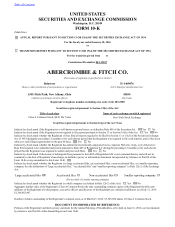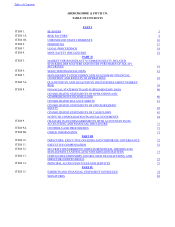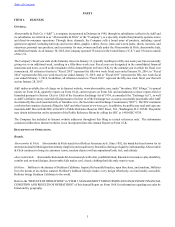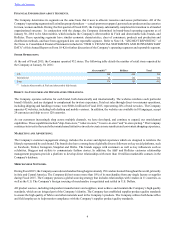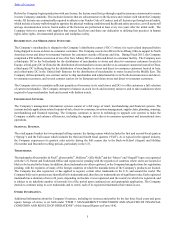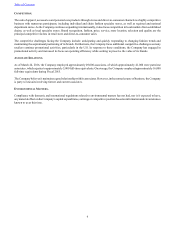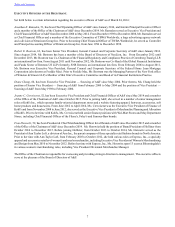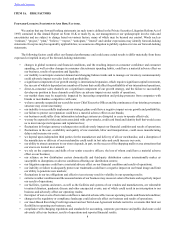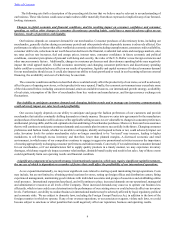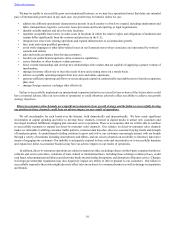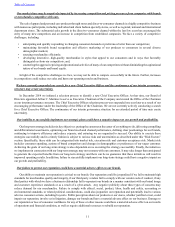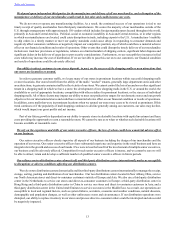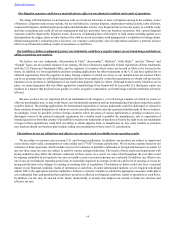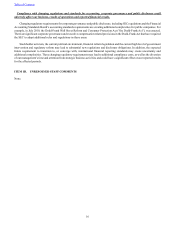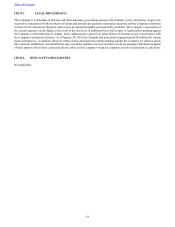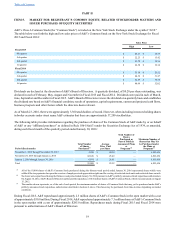Abercrombie & Fitch 2015 Annual Report Download - page 9
Download and view the complete annual report
Please find page 9 of the 2015 Abercrombie & Fitch annual report below. You can navigate through the pages in the report by either clicking on the pages listed below, or by using the keyword search tool below to find specific information within the annual report.
Table of Contents
9
The following sets forth a description of the preceding risk factors that we believe may be relevant to an understanding of
our business. These risk factors could cause actual results to differ materially from those expressed or implied in any of our forward-
looking statements.
Changes in global economic and financial conditions, and the resulting impact on consumer confidence and consumer
spending, as well as other changes in consumer discretionary spending habits, could have a material adverse effect on our
business, results of operations and liquidity.
Our business depends on consumer demand for our merchandise. Consumer purchases of discretionary items, including our
merchandise, generally decline during recessionary periods and other periods where disposable income is adversely affected. Our
performance is subject to factors that affect worldwide economic conditions including unemployment, consumer credit availability,
consumer debt levels, reductions in net worth based on declines in the financial, residential real estate and mortgage markets, sales
tax rates and tax rate increases, fuel and energy prices, interest rates, consumer confidence in future economic and political
conditions, consumer perceptions of personal well-being and security, the value of the U.S. Dollar versus foreign currencies and
other macroeconomic factors. Additionally, changes in consumer preferences and discretionary spending habits may negatively
impact the retail apparel market. Global economic uncertainty and changing consumer preferences and discretionary spending
habits could have a material adverse effect on our results of operations, liquidity and capital resources if reduced consumer demand
for our merchandise should occur. It could also impact our ability to fund growth and/or result in our becoming reliant on external
financing, the availability and cost of which may be uncertain.
The economic conditions and factors described above could adversely affect the productivity of our stores, as well as adversely
affect the pace of opening new stores, or their productivity once opened. Finally, the economic environment may exacerbate some
of the risks noted below, including consumer demand, strain on available resources, our international growth strategy, availability
of real estate, interruption of the flow of merchandise from key vendors and manufacturers, and foreign currency exchange rate
fluctuations.
Our inability to anticipate customer demand and changing fashion trends and to manage our inventory commensurately
could adversely impact our sales levels and profitability.
Our success largely depends on our ability to anticipate and gauge the fashion preferences of our customers and provide
merchandise that satisfies constantly shifting demands in a timely manner. Because we enter into agreements for the manufacture
and purchase of merchandise well in advance of the applicable selling season, we are vulnerable to changes in consumer preferences
and demand, pricing shifts, and the sub-optimal selection and timing of merchandise purchases. Moreover, there can be no assurance
that we will continue to anticipate consumer demands and accurately plan inventory successfully in the future. Changing consumer
preferences and fashion trends, whether we are able to anticipate, identify and respond to them or not, could adversely impact our
sales. Inventory levels for certain merchandise styles no longer considered to be “on trend” may increase, leading to higher
markdowns to sell through excess inventory and therefore, lower than planned margins. A distressed economic and retail
environment, in which many of our competitors continue to engage in aggressive promotional activities increases the importance
of reacting appropriately to changing consumer preferences and fashion trends. Conversely, if we underestimate consumer demand
for our merchandise, or if our manufacturers fail to supply quality products in a timely manner, we may experience inventory
shortages, which may negatively impact customer relationships, diminish brand loyalty and result in lost sales. Any of these events
could significantly harm our operating results and financial condition.
A significant component of our growth strategy is international expansion, which may require significant capital investment,
the success of which is dependent on a number of factors that could affect the profitability of our international operations.
As we expand internationally, we may incur significant costs related to starting up and maintaining foreign operations. Costs
may include, but are not limited to, obtaining prime locations for stores, setting up foreign offices and distribution centers, hiring
experienced management, maintaining good relations with individual associates and groups of associates and establishing online
retail presence. International expansion has placed, and will continue to place, increased demands on our operational, managerial
and administrative resources at all levels of the Company. These increased demands may cause us to operate our business less
efficiently, which in turn could cause deterioration in the performance of our existing stores or could adversely affect our inventory
levels. Furthermore, our ability to conduct business in international markets may be adversely affected by legal, regulatory, political
and economic risks. We are subject to domestic laws, including the Foreign Corrupt Practices Act, in addition to the laws of the
foreign countries in which we operate. If any of our overseas operations, or our associates or agents, violate such laws, we could
become subject to sanctions or other penalties that could negatively affect our reputation, business and operating results.

